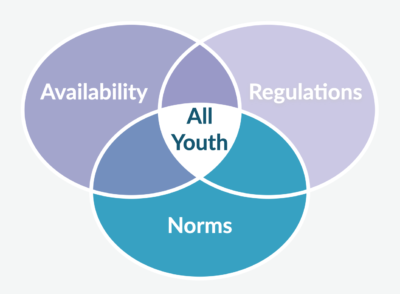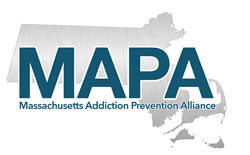
It’s a pivotal moment for organizations like MAPA, whose goal is to protect children, families and communities from drug use and addiction. As giant addiction for-profit industries push for deregulation, we must remain unified and increase our commitment to the science-based, environmental prevention strategies that research has made clear are the single most influential measure in reducing population-level alcohol, tobacco and other drug problems.
Why Environmental Prevention?
“Environmental prevention addresses the environmental factors (physical environment and community norms) that support the use of alcohol and other drugs,” says a report from the Community Prevention Initiative (CPI). “Environmental prevention brings a specific community focus to prevention, which can complement individual strategies. While individual prevention strategies focus on behavior change, environmental prevention engages a public health approach to impact substance use on a larger scale by limiting access to substances, changing public laws, policies, and practices, and changing social norms that contribute to substance use.”
Environmental prevention strategies are proven to be effective in reducing drug and alcohol abuse within communities. And substance misuse is a community problem. Aside from the moral imperative to reduce it, substance use disorder has a tremendous economic cost–to the tune of $442 billion a year in health costs, lost productivity and criminal justice costs. According to a report by the Surgeon General, environmental-based interventions (EBIs) have a $58 benefit for every dollar spent. And yet, they are rarely used: only 8 to 10% of school administrators report using EBIs and only around 11% of youth aged 12 to 17 report receiving substance misuse prevention education outside of school.
Effective, community-based policies for reducing problem use exist, and we must continue to implement them in order to present an increasingly united front of community as large corporations lobby for deregulation that will increase access to and acceptability of alcohol and drugs across communities. When it comes to addictive commodities, deregulation leads to business practices and social norms that promote and accept addiction in a for-profit scheme. It takes collective action from parents, schools, health care systems, faith-based communities, social service organizations, advocates and policymakers to successfully implement regulations and controls that work to reduce and prevent the disease of addiction and its associated harms.
What Strategies Work?
A report from the National Community Anti-Drug Coalition Institute dives deeper into strategies for environmental-based initiatives for substance use disorder prevention, including several successful examples of implementation.
In Salt Lake City, a coalition tasked with reducing alcohol use among youth indicated the importance of understanding your community’s stakeholders, addressing community education and awareness, ensuring that the strategy fits the community culture, and understanding state laws, who enforces them, and how they are enforced.
An initiative in North San Diego County to reduce youth marijuana use demonstrated how targeting both city policymakers and event organizers for music festivals and street fairs–which had a lot of messaging portraying marijuana use as “fun” and “harmless”–could create positive environmental change for youth.
Creating Culturally Sensitive Strategies That Work for Individual Communities
But as the CPI report points out, we should not assume that strategies that work for one community will work in another. “If the demographics and norms of a community are not considered and existing leaders of a given community are not included in the planning and implementation process, prevention strategies may be less relevant to community members, and consequently less well supported and less successful. Every community has a culture, and cultural responsiveness should always be a first principle of substance [misuse] prevention.”
Some of the strategies CPI suggests for culturally responsible environmental prevention include:
- Acknowledging diversity, difference and issues of oppression
- Respecting individuals, communities and cultures with whom you interact
- Building citizen-driven, rather than provider-driven, approaches
- Recognizing differing and competing views, and helping to negotiate arrangements that consider and benefit the targeted community
- Working across silos toward the holistic wellness of communities
- Being strong facilitators and organizers
Support MAPA in Bringing the Right Strategies to Massachusetts Communities
At MAPA, we continue to work toward these important environmental-based interventions at the state level and in cities and towns across the Commonwealth. Your support is essential in advancing primary prevention and reducing youth use rates. We are up against large business forces pushing to dismantle the public health standards in place that work to prevent an epidemic of Substance Misuse Disorders and its associated harms on our families and communities.
Currently, The Josephine and Lester Hensley Family Trust is offering a 100% gift match for any donations to MAPA up to $10,000. This means that any donation you make will have double the impact–a donation of $25 will net $50 for MAPA, $250 nets $500 and $1,000 nets $2,000.
Donate today to ensure that your gift is doubled and to help us as we continue in our work to prevent addiction and protect Massachusetts youth and communities from both the continued and emerging outcomes of alcohol and drug abuse.
